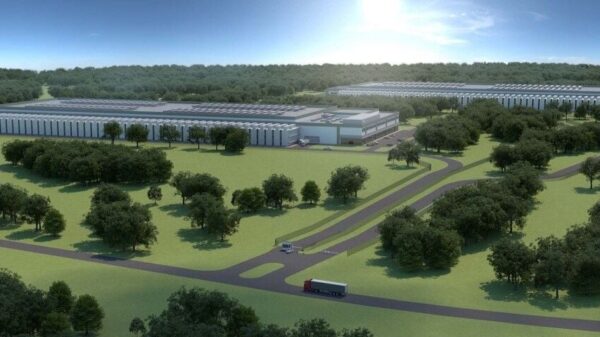The Province of Alberta is holding public consultations in the fall to discuss the benefits and detriments of adding nuclear power to the province’s energy offerings.
Premier Danielle Smith said on Monday that these conversations will start around September or October. They will be led by Chantelle de Jonge, the parliamentary secretary for affordability and utilities.
Alberta has long discussed building reactors, including ones to power oilsands operations. For now, the province relies on natural gas, which emits greenhouse gases, to generate electricity.
Smith said the government wants to speak with Albertans because nuclear energy is new to the province. She noted that Ontario already uses nuclear energy for about 60 per cent of its power. Small modular reactors likely make the most sense at remote, high-energy-use sites, she added. Additionally, Smith pointed to oilsands projects as ideal locations, especially if reactors can supply both power and heat.
Small modular reactors, or SMRs, generate about one-third the power of traditional nuclear plants and arrive prefabricated for on-site assembly.
Ontario Power Generation is building an SMR at its Darlington site east of Toronto. This project would make it the first North American power company to connect an SMR to the grid.
Additionally, the utility plans to build three more units at the site. Ford said SMRs do not employ many people once operational. However, they could attract tech giants like Amazon (NASDAQ: AMZN) or Google, which need power for artificial intelligence data centres.
“And that’s where the jobs are created because they just suck an endless amount of energy, these data centres,” said Ford.
Read more: ATHA completes 92 Energy acquisition; prepares for drill program at Gemini project in Q3
Read more: Westinghouse Electric Company inks deal to provide UK first privately-financed SMR fleet
Ontario Power Generation considering SMRs for industrial sites
A U.S.-based developer of small modular reactors sees Alberta as a promising market for expansion.
Private nuclear firm, X-Energy Reactor Co, led by CEO Clay Sell, has created a reactor design tailored to Alberta’s specific energy needs.
During the Global Energy Show in Calgary, Sell emphasized that conventional nuclear reactors are often too complex and expensive to build, even though they can operate for decades once completed.
In response, X-Energy focused on developing smaller, simpler systems with fewer components. The company is actively exploring ways to contribute to Alberta’s power grid. Furthermore, it is targeting oilsands operations that rely on steam-assisted gravity drainage, a process that extracts bitumen through wells rather than surface mining.
“Our plant is perfectly suited to perform that same mission on a small footprint,” Sell said.
Ontario Power Generation is considering X-Energy’s small modular reactors for use at industrial sites in Ontario. Additionally, a much larger conventional nuclear project is advancing in northwestern Alberta. Energy Alberta is developing a power station in the Peace River region with plans for two to four Candu reactors.
The proposed facility could generate up to 4,800 megawatts of electricity. That output would represent as much as a quarter of Alberta’s current electricity supply.
Energy Alberta filed an initial project description for the Peace River Nuclear Power Project in April, starting the federal review process.
In a June speech at the Global Energy Show, Candu Energy senior vice-president Carl Marcotte said Alberta would benefit from including nuclear in its energy mix.
Read more: Department of Energy inks deal with six companies for low-enriched uranium
Read more: F3 Uranium finds high radioactivity during summer drilling campaign in Saskatchewan
SMRs use far less cooling water
Next-generation nuclear reactors, such as small modular reactors (SMRs), could significantly reshape Alberta’s energy landscape. These compact reactors generate reliable, carbon-free electricity around the clock. They offer a steady power source to balance the variability of renewables like wind and solar. Additionally, SMRs produce both electricity and heat, making them ideal for industries that require high thermal output.
Oilsands operations could especially benefit. SMRs can supply both steam and power to support extraction methods like steam-assisted gravity drainage. This reduces dependence on natural gas and cuts emissions. Further, their small footprint allows for installation at remote or industrial sites with limited infrastructure.
SMRs also use far less cooling water than traditional nuclear plants, expanding possible locations. Their factory-built components speed up construction and lower upfront costs. Alberta could use this modular approach to deploy reactors more quickly and efficiently than large-scale nuclear facilities.
These reactors could also power isolated communities that now rely on costly diesel. Replacing diesel with SMRs could lower energy costs while reducing emissions. Additionally, SMRs support economic diversification by creating jobs in manufacturing, engineering, and operations.
They strengthen Alberta’s energy security by providing stable, domestically produced power. SMRs also complement renewable sources by filling in gaps during low production periods. In the long term, they could position Alberta as a leader in nuclear technology, both nationally and internationally.
With proper support and oversight, SMRs could offer Alberta a path toward cleaner, more reliable, and more resilient energy.
.
joseph@mugglehead.com














